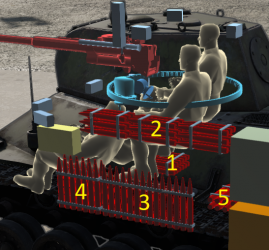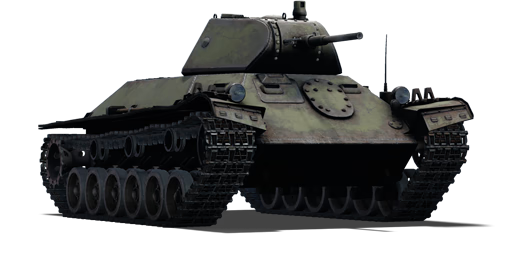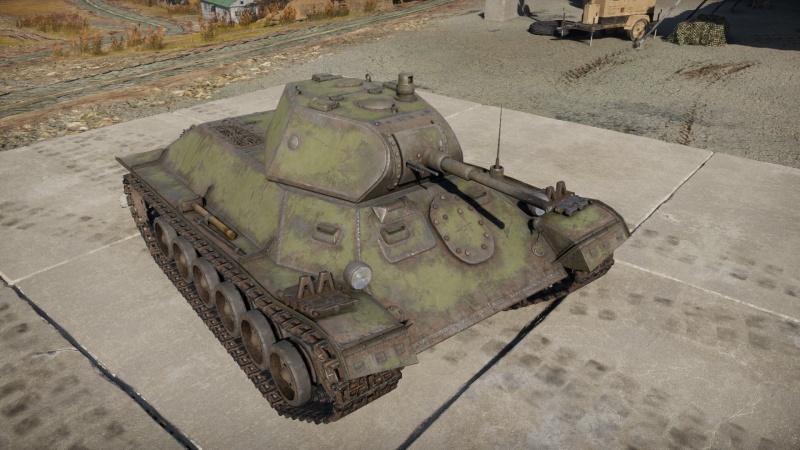Difference between revisions of "T-126"
(Updated format) |
Colok76286 (talk | contribs) (→External links: Edits) |
||
| Line 199: | Line 199: | ||
''Paste links to sources and external resources, such as:'' | ''Paste links to sources and external resources, such as:'' | ||
* ''topic on the official game forum;'' | * ''topic on the official game forum;'' | ||
| − | |||
* ''other literature.'' | * ''other literature.'' | ||
{{USSR light tanks}} | {{USSR light tanks}} | ||
{{USSR premium ground vehicles}} | {{USSR premium ground vehicles}} | ||
Revision as of 16:29, 24 April 2021
Contents
Description
The T-126(SP) is a premium rank II Soviet light tank with a battle rating of 3.0 (AB/RB/SB). It was introduced in Update 1.47 "Big Guns".
A premium version of the T-50, it shares it similarities due to being its prototype design, but actually is better due to much thicker all-around armour. An unfortunate side effect results in a decrease in top overall speed due to weight of added armour.
General info
Survivability and armour
Compared to the T-50, the T-126 can boast a better all-around armour for both the hull and turret. The only areas that the T-126 had same or weaker armour compared to the T-50 is the roof and the rear armour.
The front hull has the most impressive improvement, from a 40 mm plate on the T-50 to a 55 mm plate at the same sloping angle. This gives the T-126 a front armour protection similar to that of a medium tank, which is enough to shrug off most tank armament kinetic shells at a distance. The T-126 can even compound angle itself towards the enemy to present significant armour thickness on the front and side armour.
With the rather thick armour all-around the tank, a T-126 does not need to worry much about how they are presenting the tank towards the enemy when taking enemy fire. The only concerns would be shots directly perpendicular to the side armour, which can hit the ammo rack or crew.
The crew is tightly packed in the light tank, and so a penetrating shot through the front armour is most likely to knock out most, if not all, of the crew in a single shot. Shots to the side hull armour are also concerning as a large line of ammo racks line the port side of the hull, which means a clean penetration on either side of the hull can hit one of these racks and detonate the ammunition. The fuel and engine in the rear are also a concern, but are packed there isolated from the crew. They may also absorb any shells coming directly from the T-126's rear armour, protecting the crew. However, this will immobilise the T-126 and allow the enemy to flank for a side shot that will hit thez ammo rack of crew.
Armour type:
- Rolled homogeneous armour
| Armour | Front | Sides | Rear | Roof |
|---|---|---|---|---|
| Hull | 55 mm (53-54°) Front glacis 45 mm (53°) Cheeks 45 mm (44°) Lower glacis |
45 mm (38-41°) Top 45 mm Bottom |
30 mm (56°) Top 30 mm (5-42°) Bottom |
15 mm |
| Turret | 45 mm (6-72°) Turret front 40 mm (9-48°) Gun mantlet |
45 mm (24-27°) | 45 mm (24°) | 15 mm |
Notes
- Suspension wheels and tracks are 15 mm thick in armour.
Mobility
With the same 300 hp engine (572 hp in arcade) as the T-50, the T-126 has a significant difference in movement characteristics due to being about 5 tons heavier. Despite this, the T-126 is a rather quick vehicle. The forward acceleration is great and the T-126 can reach a sufficiently high forward speed quickly. Turning when moving can also be done in bursts for fast correction courses, but prolonged turning will drain the speed quickly.
The speed the T-126 is able to pick up makes it able to perform in a scout or flanking role on the battlefield.
| Game Mode | Max Speed (km/h) | Weight (tons) | Engine power (horsepower) | Power-to-weight ratio (hp/ton) | |||
|---|---|---|---|---|---|---|---|
| Forward | Reverse | Stock | Upgraded | Stock | Upgraded | ||
| Arcade | 40 | 6 | 18.3 | 465 | 572 | 25.41 | 31.26 |
| Realistic | 36 | 5 | 265 | 300 | 14.48 | 16.39 | |
Modifications and economy
Armaments
Main armament
The 45 mm 20-K cannon is familiar to those researching the Soviet tech tree, making up the main armament of the reserve tanks BT-5 and T-26. However, at rank II, the 45 mm starts to feel lacking at a distance against the even medium tanks. This is made up with the availability of APCR rounds for the cannon, but this is only useful at targets less than 1 kilometres due to the faster penetration drop-off and also on flat armour due to the poor slope attack characteristics of APCR.
| 45 mm 20-K | Turret rotation speed (°/s) | Reloading rate (seconds) | |||||||||||
|---|---|---|---|---|---|---|---|---|---|---|---|---|---|
| Mode | Capacity | Vertical | Horizontal | Stabilizer | Stock | Upgraded | Full | Expert | Aced | Stock | Full | Expert | Aced |
| Arcade | 150 | -8°/+25° | ±180° | N/A | 7.62 | 10.54 | 12.80 | 14.16 | 15.06 | 3.77 | 3.34 | 3.07 | 2.90 |
| Realistic | 4.76 | 5.60 | 6.80 | 7.52 | 8.00 | ||||||||
Ammunition
| Penetration statistics | |||||||
|---|---|---|---|---|---|---|---|
| Ammunition | Type of warhead |
Penetration @ 0° Angle of Attack (mm) | |||||
| 10 m | 100 m | 500 m | 1,000 m | 1,500 m | 2,000 m | ||
| BR-240 | APHEBC | 70 | 68 | 59 | 50 | 42 | 35 |
| BR-240SP | AP | 73 | 71 | 62 | 52 | 44 | 37 |
| BR-240P | APCR | 106 | 99 | 72 | 49 | 33 | 23 |
| Shell details | |||||||||
|---|---|---|---|---|---|---|---|---|---|
| Ammunition | Type of warhead |
Velocity (m/s) |
Projectile Mass (kg) |
Fuse delay (m) |
Fuse sensitivity (mm) |
Explosive Mass (TNT equivalent) (g) |
Ricochet | ||
| 0% | 50% | 100% | |||||||
| BR-240 | APHEBC | 760 | 1.43 | 1.2 | 9 | 29.26 | 48° | 63° | 71° |
| BR-240SP | AP | 757 | 1.43 | N/A | N/A | N/A | 47° | 60° | 65° |
| BR-240P | APCR | 1,070 | 0.85 | N/A | N/A | N/A | 66° | 70° | 72° |
Ammo racks

| Full ammo |
1st rack empty |
2nd rack empty |
3rd rack empty |
4th rack empty |
5th rack empty |
Visual discrepancy |
|---|---|---|---|---|---|---|
| 150 | 121 (+29) | 91 (+59) | 61 (+89) | 31 (+119) | 1 (+149) | Yes |
Machine guns
| 7.62 mm DT | ||||
|---|---|---|---|---|
| Mount | Capacity (Belt) | Fire rate | Vertical | Horizontal |
| Coaxial | 1,890 (63) | 600 | N/A | N/A |
Usage in battles
Describe the tactics of playing in the vehicle, the features of using vehicles in the team and advice on tactics. Refrain from creating a "guide" - do not impose a single point of view but instead give the reader food for thought. Describe the most dangerous enemies and give recommendations on fighting them. If necessary, note the specifics of the game in different modes (AB, RB, SB).
Pros and cons
Pros:
- Up-armoured angled front plate giving good protection
- Serviceable cannon at its rank
- Angled armour all around upper hull
- Decent mobility
Cons:
- Slow turret rotation
- Gun mantlet is a significant weakspot
- Struggles in an up-tiered battle
- Cheeks on the corner of the frontal armour, which results in massive weakspots if you are not facing enemies
- Limited gun depression
- 4-man crew extremely tightly packed - a penetrating APHE can easily knock out all 4
History
Development
The Spanish Civil War gave the Soviets insight on the future of tank warfare, and the knowledge led to an attempt to upgrade or replace their tank forces that consisted mainly of the T-26 light tanks. The development started in 1939 to create a replacement with for the T-26 and BT light tanks.
The project for the new tank began as the SP project, which is short for Soprovzhdeniya Pekhoty, which means "Infantry Support". The project was headed by the OKMO tank design bureau at the S.M. Kirov Factory No. 185 in Leningrad under the individuals L. Troyanov and I. Bushnevov. Two prototypes, the T-126 and the T-127 was built, and the T-126 was to be further developed into the finished design. The finished design would become the T-50 light tank, which was an intricate light tank for the Soviets at the time. The tank featured sloping armour, torsion bar suspension, diesel engine, three-man turret, and a commander's cupola, all of which were advanced features at the time.
Production
The tank would eventually be produced in 1941 during the German invasion in Operation Barbarossa. Only 69 T-50s were made before production ended in January 1942, the design suffered from being expensive, unreliable, and over-engineered. Today, two T-50 survive in intact condition, one normal variant in the Kubinka Tank Museum, and an up-armoured variant in Finland at a museum in Parola.
In-game description
The T-126 experimental light tank was built in the summer of 1940 at Leningrad Experimental Automobile Factory #185. The project was developed on the basis of combat experience in Spain with the goal of creating a tank suitable for the conditions of future wars. Only one model of the tank was ever built, and it was never used in combat.
Media
- Skins
- Videos
See also
- T-50 - Production version of the T-126.
External links
Paste links to sources and external resources, such as:
- topic on the official game forum;
- other literature.
| USSR light tanks | |
|---|---|
| T-26 | T-26 · T-26 (1st Gv.T.Br.) · T-26-4 · T-26E |
| BT | BT-5 · RBT-5 · BT-7 · BT-7 TD · BT-7M · BT-7A (F-32) |
| T-50 | T-126 · T-50 |
| T-70 | T-70 · T-80 |
| PT-76 | PT-76B · PT-76-57 · Object 906 |
| BMP | BMP-1 · BMP-2 · BMP-2M · BMP-3 |
| BMD | BMD-4 |
| 2S25 | 2S25 · 2S25M |
| Wheeled | BA-11 · BTR-80A |
| Other | T-60 · Object 685 · 2S38 |
| China | ▂Type 62 |
| USSR premium ground vehicles | |
|---|---|
| Light tanks | BA-11 · RBT-5 · BT-7A (F-32) · T-26 (1st Gv.T.Br.) · T-26E · T-126 · PT-76-57 · 2S38 |
| Medium tanks | T-34 (Prototype) · T-34 (1st Gv.T.Br.) · T-34E · T-34-57 (1943) · T-34-85E · T-34-100 · T-44-122 · TO-55 · T-55AM-1 · T-72AV (TURMS-T) · T-80UD · Т-80U-Е1 |
| ▂M3 Medium · ▂M4A2 · ▂T-III · ▂T-V · ▂МК-IX "Valentine" | |
| Heavy tanks | SMK · T-35 · ▂MK-II "Matilda" · KV-1E · KV-2 (1940) · KV-2 (ZiS-6) · KV-122 · KV-220 · IS-2 "Revenge" · Object 248 · IS-6 · T-10A |
| Tank destroyers | BM-8-24 · BM-13N · BM-31-12 |
| SU-57 · SU-76D · SU-76M (5th Gv.Kav.Corps) · SU-85A · SU-100Y · SU-122P · Object 120 | |
| SPAA | ▂Phòng không T-34 · ZUT-37 |





